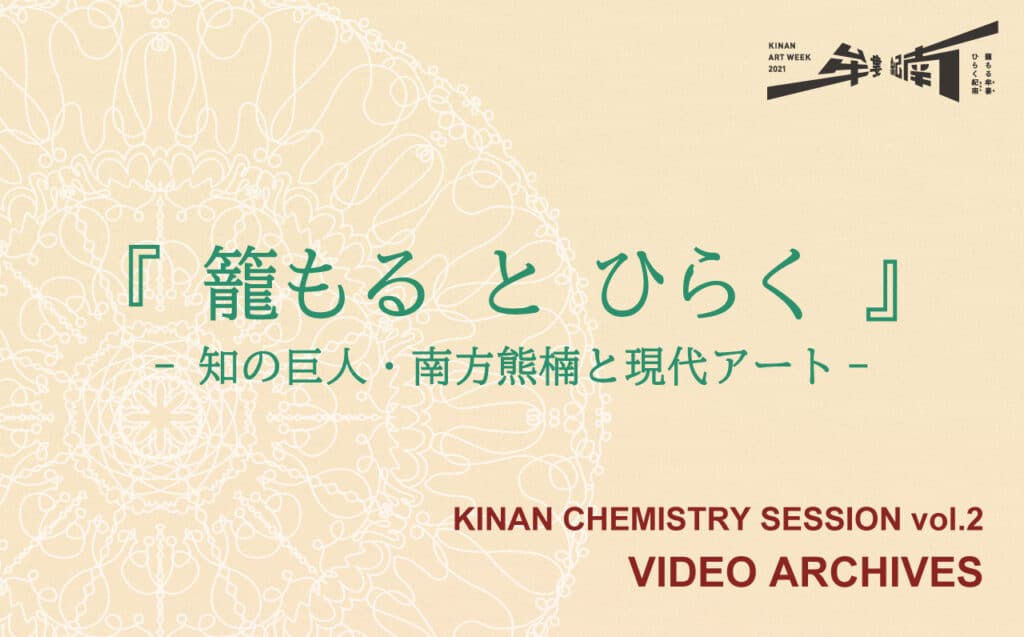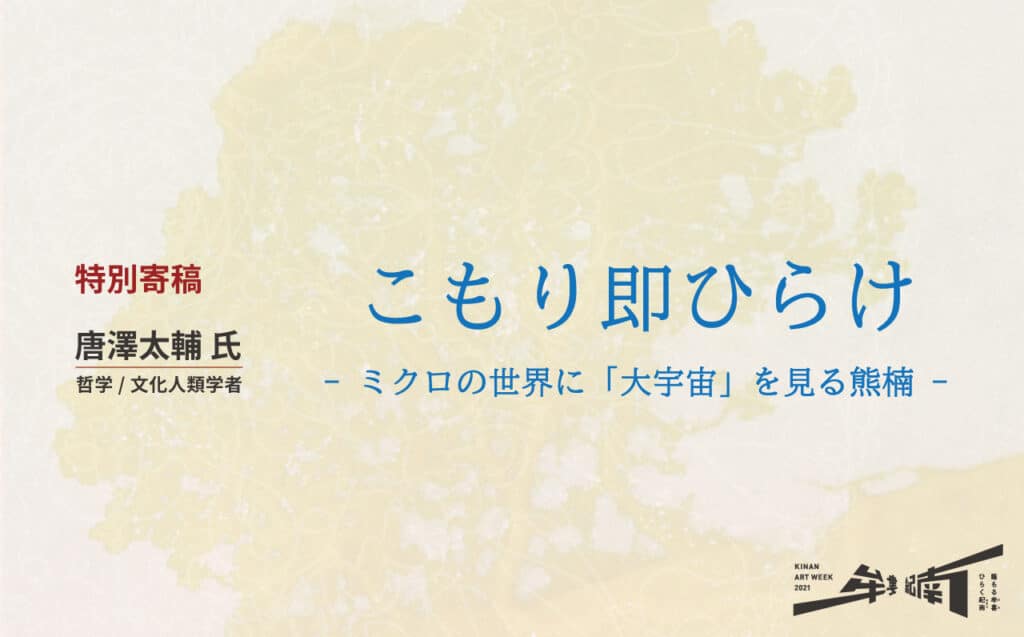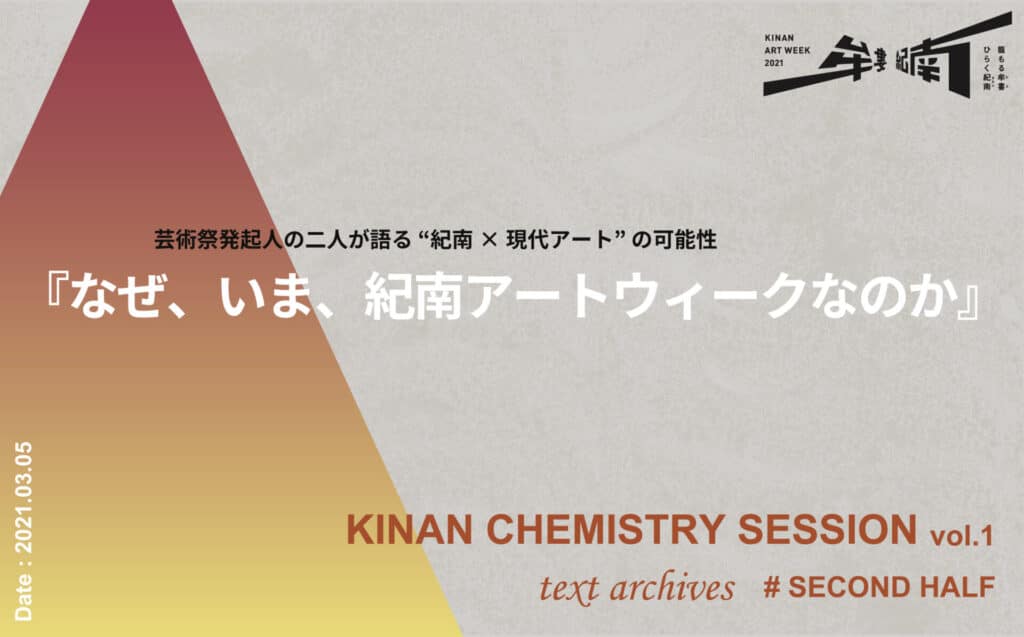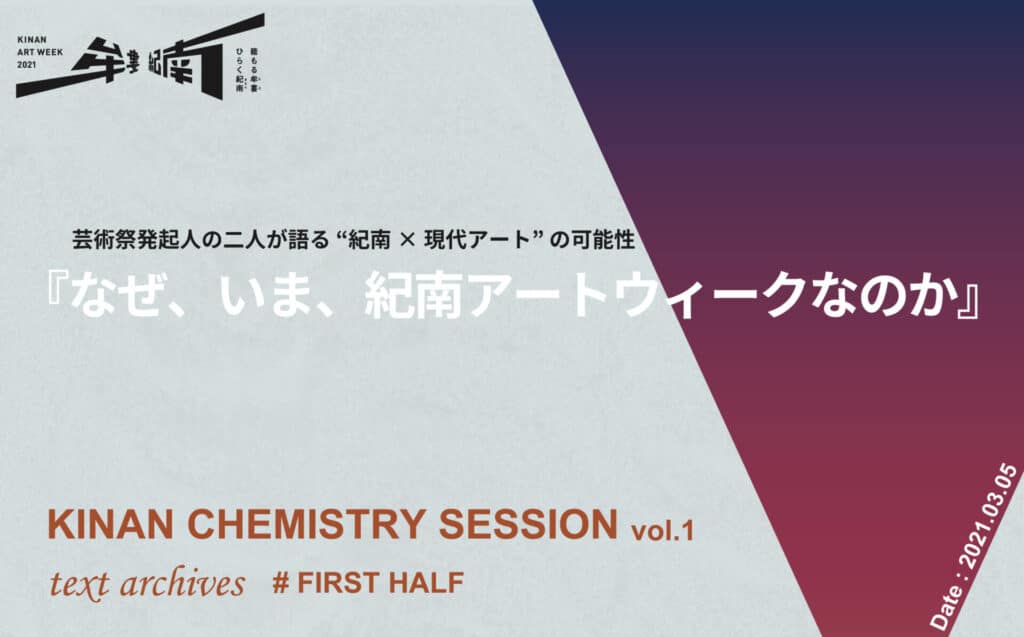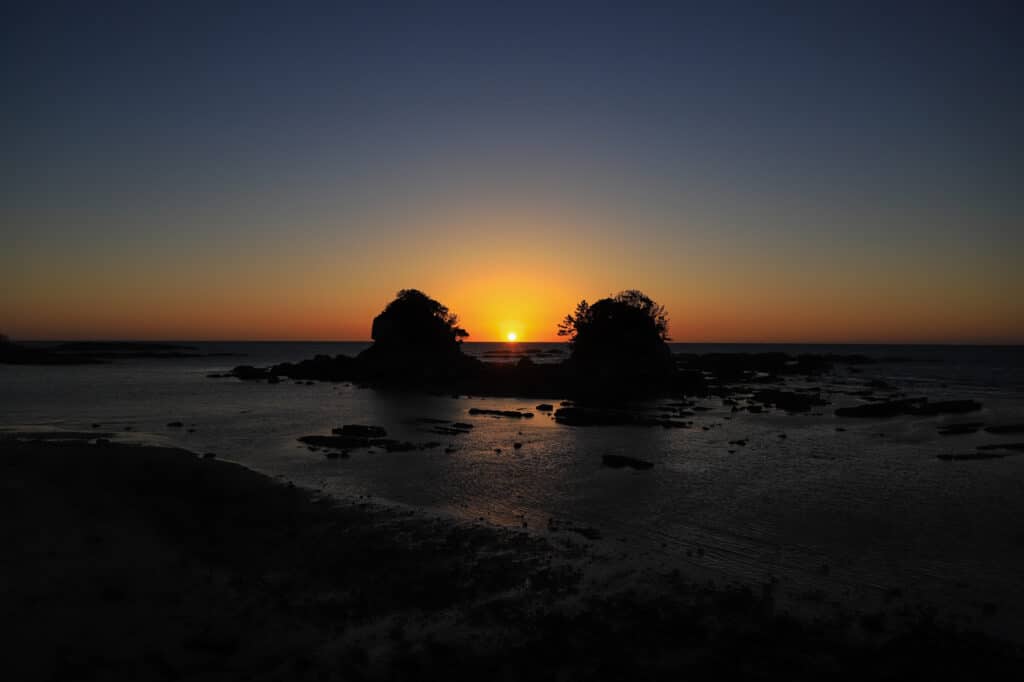Dialogue
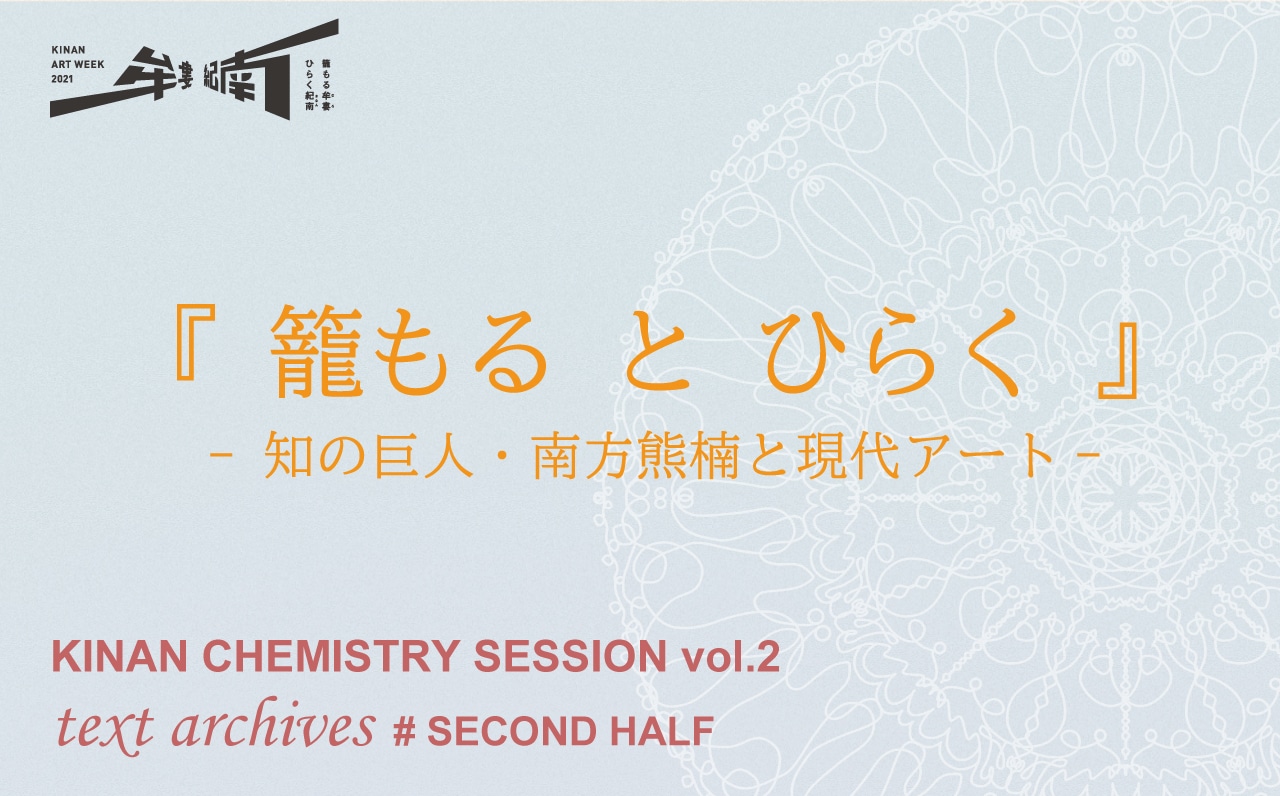
Archived Text (Second Half) of Kinan Chemistry Session vol.2 “Seclusion and Openness: Kumagusu Minakata, the Giant of knowledge and Contemporary Art”
Online talk session “Kinan Chemistry Session vol.2” held on May 28, 2021
This is the second half of a text archive that transcribes an incandescent session.
*Click here for the text archive (First half)
https://kinan-art.jp/en/info/937/
*Click here for the video archive
https://kinan-art.jp/en/info/792/
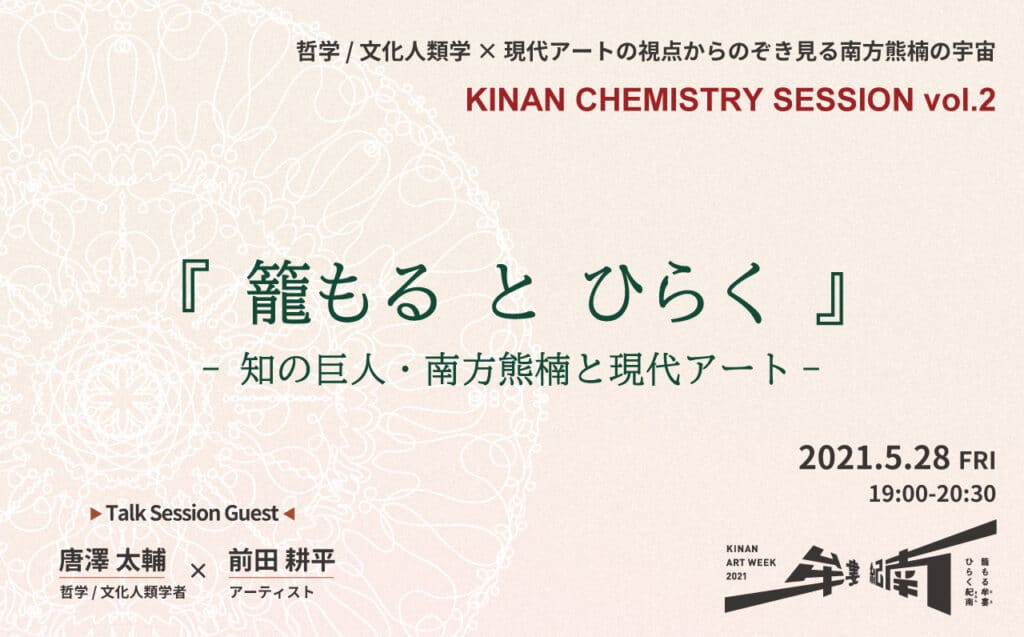
Title: “Seclusion and Openness – Kumagusu Minakata, the Giant of Knowledge and Contemporary Art – ”
Date and Time: Friday, May 28, 2021, 19:00 – 20:30
Venue: Online (ZOOM webinar)
Participation Fee: Free
Speakers: Taisuke Karasawa (Associate Professor of Philosophy / Cultural Anthropology, Akita University of Art)
Kohei Maeda (Contemporary Artist)
Moderator: Daisuke Miyatsu (Artistic Director, Kinan Art Week)
General Moderator: Ryota Morishige (Regional Revitalization Producer)
Seclusion and Openness – Kumagusu Minakata, the Giant of Knowledge and Contemporary Art –
【3】 The Meeting of the Two
Miyatsu:
Earlier, Dr. Karasawa said, “I believe that art is the way in which the roots of life and various things emerge by going directly into “ri fushigi” (the wonder of principles)”. I feel that Maeda’s works are very close to that. They are exactly the two people who were meant to meet.
The Miracle of Kumagusuku
Miyatsu:.
Mr. Maeda told us that he came across Dr. Karasawa’s book while continuing his research. How did the two of you meet?
Karasawa:
I think it would be best to start from your side, Maeda-kun (laughs).
Maeda:
Okay, I’ll talk first (laughs).
In graduate school, when I decided to think about Kumagusu Minakata, I came across a strange hotel (now a small art complex) in Kyoto with the trade name “Kumagusuku *“. When I decided to check out Kumagusuku, I found this place, so I immediately poked around and talked to the owner, an artist named Yoshitaka Yazu *, who I told that I was working on something like this. Both Mr. Yazu and I were reading Dr. Karasawa’s book, and he happened to show up at the place.
*Reference: kumagusuku homepage
*Reference: Yazu Yoshitaka website
*Reference: Yoshitaka Yazu (kumagusuku)@yazuyoshitaka(Twitter)
Miyatsu:
Was that a coincidence?
Maeda:
It was a coincidence (laughs). Just as we were talking about Dr. Karasawa, the author came to visit kumagusuku. I was surprised, “This is amazing!” I thought. At that time, Mr. Yazu, I and Dr. Karasawa had a lively conversation and I told Dr. Karasawa what I wanted to do and what I was researching about Kumagusu. I asked him, “What is “mono fushigi” (the wonder of substance)?” “The Minakata Mandala is amazing! and afterasking many questions, we decided to have a “research night meeting” once a month, and we have been keeping in touch with each other ever since.
Miyatsu:
Mr. Yazu, the owner of Kumagusuku and an artist, and Mr. Maeda, an artist who was doing research on the theme of Kumagusu. When the two of them were talking about Kumagusu and saying “Dr. Karasawa is interesting”, he came by chance.
What made you decide to go to Kumagusuku, Dr,Karasawa?
Karasawa:
At that time, I was starting to study Kegon thought at Ryukoku University in Kyoto, in order to deepen my understanding of Kumagusu’s thought. When I was researching about Kumagusu on the Internet, I found Kumagusuku and thought, “I should visit there, it’s so close to the university.” One day, I went to Kumagusuku and happened to meet the two of you (laughs).
This event really feels like “yariate” to me. I have often talked about Kumagusu in my lectures and books, but I have never been asked such a frank question as Mr.Maeda, “What is “mono fushigi” (the wonder of substance)?” I had never experienced such a frank question like that . So, I was very happy and we started to talk about various things.
Miyatsu:
It’s a true “yariate”. Synchronicity, a match beyond coincidence. I think it is a perfect match for this word coined by Kumagusu.
Beginning of the Research Night Meeting
Miyatsu:
After you met at Kumagusuku, you held a research night meeting, may I ask more about this?
Karasawa:
Mr.Maeda told me that he wanted to make a work on the theme of Kumagusu, so I decided to teach him what I had been studying. Since I am not an artist, my main focus was on Kumagusu’s thoughts. From the core of Kumagusu’s thought, “What is the Minakata Mandala?”, I proceeded to talk about Shintoism, Buddhism, and many other topics. Mr. Yazu joined us, and the combination of modern art and Kumagusu created a “chemical reaction”.
Mr.Maeda was able to absorb what I taught him at the research night meeting and eventually presented his work in the form of a large kite.
Mr.Maeda, flying the kite was very difficult (laughs), because when I flew it in Kyoto in February, it only flew a little, but when I flew it again in Wakayama, it flew fine.
Maeda:
Yes, that’s right. That’s how it happened (laughs).
Research Night Meeting “Results”
Miyatsu:
Mr.Maeda, I think you decided on one theme for your research in graduate school and showed the results when you finished your master’s program, but was the big kite the result of that?
Maeda:
It was. I presented it as my graduation project.
Miyatsu:
The face of the kite, as explained earlier, is a combination of Kumagusu’s and Mr. Maeda’s faces. I would like to know more about why you made the kite and drew a face combining yours and Kumagusu, and what did you do at the research night meeting to make the kite.
Maeda:
The research night meetings were held once a month for the entire year. During that time, I would repeatedly pull around a stall to go talk to various people, think about the content, and output it in different forms.
The theme for the research night meeting was like chasing the Minakata mandala. We began with the question, “What is the substance?”. When we got to , “What is the event?” which was the third question, it was suggested that a situation or a place where a lot of people are talking, such as the research night, would be a good place for this sort of question.
After that, we decided to open the research night meeting to the public as a place for experiments. Usually, it was just me, Dr. Karasawa, and Mr. Yazu, but for ten days, I lived in the courtyard of Kumagusuku and stayed there. Every day, various people would gather and talk about various things, and I felt as if something was rising up, and I thought that this would be a “trigger” for capturing the “koto fushigi” (the wonder of facts or events).
Earlier, Dr. karasawa talked about microscopic slime mold and the macrocosm, and I thought the situation of communicating with something on an unknowable cosmic scale was like flying a kite: “It’s connected by something like a rope, and even if you pull it in, it will soon fly away.
It’s not just a kite, it’s a very big kite. When it flies far away, it becomes small, but when it gets closer, there is something scary, like it is coming at you, or staring at you, and it looks like a human face or eyes. The kite I made has four eyes, and my eyes and Kumagusu’s eyes are just overlapping, and they are looking at me. I thought that by flying the kite together, we could understand things on a cosmic scale.
The more I think about Kumagusu, the more I don’t understand him, but I really enjoy that situation. At first we were just talking about slime mold, but then the conversation expanded to the realm of anthropology and folklore. I found it interesting that I could be a part of it, and the situation looked like flying a kite . Eventually, I wanted to show it to people, so I made a video of the big kite flying.
Miyatsu:
I see. So the face of the kite is a combination of Mr. Maeda’s and Kumagusu Minakata’s faces.
The kite looks big before it is flown, but when it flies far away, it looks small. The way the kite looks depends on where the viewer is standing and what condition the kite is in.
While continuing the research night meetings with Dr. Karasawa and Mr. Yazu, Mr. Maeda was walking around the city pulling a cart, listening to various stories, and outputting them. This kite is one of the outputs, but I thought that this work itself is an “interface between things and between people,” and that it is truly “ri fushigi” (the wonder of principles). How did you feel when you saw the completed kite, Dr.Karasawa?
Karasawa:
It was like, “Oh, You’ve made it here!” That’s how I felt. The faces of Mr.Maeda and Kumagusu are superimposed on the face of the kite, but it is interesting that it looks like either of them. It is interesting to see that the faces of Mr.Maeda and Kumagusu overlap, but they look like both of them. The face of Mr.Maeda and the other of Kumagusu are subtly mixed, but not completely fused. I thought, “this could also be a ‘ri fushigi’ (the wonder of principles)”.
I was also really impressed that they had thought about the micro and macro aspects of the kite, such as how it flies far away and looks small, and how it comes closer and looks bigger.
Mr. Maeda went around Kyoto pulling a food cart as part of his fieldwork, and I think he has the ability to get people involved. I don’t think Maeda is a good negotiator, but I think his pure curiosity overflowing from his whole body is conveyed to others not through words but through atmosphere. That’s probably why He was able to build a kind of deep connection that goes beyond words while pulling the stalls. I think this is also where the interface, “ri fushigi” (the wonder of principles), comes into play.
Why the way I look at art has changed
Miyatsu:
At present, Dr. Karasawa, who specializes in philosophy and cultural anthropology, is an associate professor in the Arts and Roots Department at Akita University of Art. Could it be that his encounter with Mr. Maeda brought about a change in his life as well?
Karasawa:
It’s been quite a change (laughs). Before I met Mr.Maeda, I used to think that contemporary art was “fashionable and sophisticated”. However, Maeda’s works are wild and full of heat, and he made me realize that “art can be so interesting!” This was a big change for me.
After that, I began to take an interest in contemporary art, and thinking about it now, I think that Mr.Maeda may have decided my destination . Is that saying too much? (laughs).
Maeda:
That’s an exaggeration.(laughs)
Miyatsu:
It was a good “yariate” for both of you, and it created a chemical reaction.
【4】 “Seclusion and Openness” and Kumagusu Minakata
Miyatsu:
Finally, I would like to ask about the theme of this chemistry session, “Seclusion and Openness”, and the relationship between Kumagusu’s research and his way of life.
As the subtitle of Kinan Art Week suggests, the Kinan region of Wakayama Prefecture has long been home to both a “culture of seclusion” in which people pursue their own inner worlds in the midst of rich mountain and forest resources, and a “culture of port,” which serves as a place of openness, such as today’s Nanki-Shirahama Airport *.
As you can see, “Seclusion” and “Openness” seem to be contradictory, but I feel that they strengthen each other. With this in mind, I would like to ask you for a few words.
*Reference About(KINAN ART WEEK 2021)
The “Great Universe” as Seen through slime mold
Karasawa:
In his youth, Kumagusu studied in the U.S., Cuba, and London. However, after his return to Japan, Kumagusu hardly went out of Wakayama, let alone abroad. At first glance, it seems as if Kumagusu’s world had been closed, but this is a big mistake. In fact, his inner world was open to the outside world. Kumagusu was also looking deeply into himself, as if through meditation, we can look deeply into ourselves, which will lead us to a universal place.
If I had to pick one thing that led me to “open up while staying inside,” I would have to say slime mold. Kumagusu may have realized that looking at small things is not only connected with “hiding”, but also with “opening up”.
In relation to “port”, Kumagusu spent most of his life in seaside towns like Wakayama City and Tanabe City. As Kumagusu was also interested in seaweeds *, he must have collected sea creatures and looked at them under a microscope, feeling the macrocosm in them.
Kumagusu was a “fisherman” who was wild, fierce and outgoing, and a “mountain man” who was quietly looking inside himself while confronting trees and animals. That’s the interesting thing about Kumagusu, and the relationship between Nachi mountain, the port, and Wakayama’s great resource attraction and Kumagusu.
*Reference: Taiki Kitayama, “Minakata Kumagusu’s Seaweed Specimens: The Case of the National Museum of Nature and Science” (AlgaeMarch10, 2018, Vol.66,No.1p. 41, The Algal Society of Japan)
Miyatsu:
So Kumagusu embodies the idea of enjoying the macrocosm with only one microscope and knowing the truth.
Opposition to the enshrinement of Shinto shrines
Miyatsu:
Kumagusu loved nature as well as slime mold and seaweed, but when the enshrinement of shrines * was proposed, he was very much against it, wasn’t he?
*Reference: Movement against the enshrinement of shrines (Minakata Kumagusu Memorial Hall)
Karasawa:
That’s right. The reason why Kumagusu joined the movement against the shrine enshrinement was his “anger” at the fact that the shrine where he found a rare slime mold was enshrined and the land was cleared. It is a very personal reason, but since his name is “Kuma and Kusunoki,” I might have thought that having the camphor tree (=Kusunoki) in the shrine’s forest cut down and the bear (=Kuma) disappearing would be like having his own body cut down. The opposition movement may sound like “for the sake of the world, for the sake of people”, but I believe that deep inside Kumagusu’s heart was the awareness of “protecting his own life”.
Miyatsu:
Not only in ecological issues, but also, for example, in gender and diversity issues, there is a famous saying, “What is personal is political *4“, and Kumagusu may have been anticipating such things from that very time.
*4 The slogan of “second wave feminism” in the United States in the 1960s and 1970s.
He called for the domination and oppression of women that occurs in the private sphere, such as in the family, to be viewed as public (political).
Yuri Horie, “‘Personal is Political’ wo meguru bunsatsu” (“Feminism as ‘Resistance’: AReport from the Research Center for Ars Vivendi”March2016,vol.24p. 124-152, Institute of Ars Vivendi, Ritsumeikan University
Presentation to Emperor Showa
Miyatsu:
Kumagusu was striving to protect nature, and among the places he protected is “Kashima”, which is also the name of his high school. Kumagusu guided the Showa Emperor to the island, didn’t he?
Karasawa:
Yes, on June 1, 1929, the Showa Emperor landed on Kashima and collected slime mold there *.
*Reference: Lecture and dedication to Emperor Showa (Minakata Kumagusu Memorial Hall)
Miyatsu:
It’s even more amazing than it is now for a scholar in the wild to do something like that, isn’t it?
Karasawa:
It’s really a big deal. I think it is very unusual for someone who was not a famous professor belonging to a university or research institute, but someone who was doing research on his own, to give a lecture *5 to Emperor Showa.
*5. Giving academic lectures in front of emperors and nobles.
What is an advance course?
Miyatsu:
It was before the war, so it was just like giving a lecture to a living god.
At that time, Kumagusu wrote poems for His Majesty *, but I guess the existence of Emperor Showa was more important to Kumagusu than we think.
*Reference: Presentation of specimens to the Emperor Showa and his lecture (Minakata Kumagusu Memorial Hall)
Karasawa:
I think Emperor Showa must have been quite shocked when he met the Kumagusu. Emperor Showa would have been surprised by Kumagusu’s knowledge. And above all, the box in which he presented his specimens of slime mold and plants to the Emperor was not a paulownia box, but a caramel ball box* had a strong impact.
*Reference:The Mysterious Relationship between Minakata Kumagusu and Milk Caramels: The Amazing Use of Milk Caramel Boxes (Morinaga Digital Museum)
Miyatsu:
The box of specimens to be presented to His Majesty was a caramel box instead of a paulownia box?
Karasawa:
That’s right. Maybe the Showa Emperor was also fascinated with Kumagusu’s work.
Miyatsu:
I heard that Emperor Showa was interested in biology and studied various things including slime mold. Beyond the frame of “a titan of knowledge and a living God”. did Kumagusu and Emperor Showa have a relationship as scholars or lovers of biology?
Karasawa:
I think there were more differences in status than there are now, so the fact that people can connect with each other across such barriers is very impressive. That people of completely different status can connect with each other is truly “chemistry in action,” isn’t it?
I don’t mean to compare Kumagusu with the Emperor Showa, but I think that Mr.Maeda and I have the same kind of relationship. It’s not that Mr. Maeda is going to be a philosopher or I am going to be an artist, but it’s an exquisite relationship where individuals are still individuals, but they mix well together. I feel that this relationship will lead to a sense of wonder, and I think that this way of being will become very important in the future.
Miyatsu:
If the two of you had not met, both Dr. Karasawa and Mr. Maeda might have taken different paths. I feel that Dr. Karasawa’s research field and Mr. Maeda’s style would have been completely different. The relationship between the two of you is a chemistry, or in Kumagusu’s words, a “yariate”.
[5] Question and answer session
Morishige:
Thank you very much, Dr. Karasawa, Mr. Maeda and Dr. Miyatsu.
It was a very heated session. I was drawn into Kumagusu’s world as we talked, and it was very interesting.
Participants, if you have any comments or questions, please feel free to leave them in the chat box.
Question from Dr. Karasawa to Mr. Maeda: What is the “tactile” for Mr. Maeda?
Karasawa:
Before the questions come, may I ask Mr.Maeda a question?
You make use of video installation *6, and performances that fully use his own body in his works, and I think that many of his works are particularly “tactile” in nature. Whether it’s a video or a kite, there is a pleasant tactile sensation that makes your skin tingle. I would love to hear what “tactile” means to you, Mr.Maeda.
*6 To present a work of art as a total artistic space, incorporating the environment in which it is displayed.
What is Installation (Kotobank)
Maeda:
I not only enjoy the “tactile” sensation of touching and kneading clay, but I also really like to “think about things that I cannot see with my eyes and do not know where they are.” For example, in one of my works, I was thinking about love *, and there was a moment when I was able to touch and feel the outline of something that I couldn’t capture with my eyes by creating the work.
In other words, I believe that ”through art, we can touch the invisible.” For example, in the story of the kite, we can touch the rope of the kite and pull it, but we cannot actually touch Kumagusu. But somehow, I feel as if I could talk to Kumagusu, or understand something about him. Maybe this is what “tactile sensation” means to me.
*Reference: “Love Noise” (Kohei MAEDAportfolio site)
Karasawa:
I think what is expressed in Mr. Maeda’s works is not ordinary touch, or touching, but “tact *7” in Kumagusu’s words. Kumagusu thinks that “tact is necessary for yariate”, but he couldn’t translate that word in Japanese. If you look up the word in a dictionary, you will find the meaning of “tact”, you would find the meaning: “the ability to do something with a nimble wits”, but the origin of the word is the Latin word “tactus”, which originally means “tactile sense”. I think “tact” is to go deep into the objects physically and psychologically and feel the deepest part of them.
I think what Mr. Maeda is practicing in his works is not touch, but “tact,” which means “sense of touch.” Maybe that’s why there are so many “yariate” happening one after another around Maeda. When I look at his works, I always feel that he values “touch” very much.
*7 The ability to freely select and combine materials from among the available materials (≒ a treasure trove of ideas).
[reading club vol.2Kumagusuku and Art]-Chapter 3″Yariate” andTACT(October14,2017,kumagusuku)
Question 1: Is Mr. Maeda’s work available on the web?
Morishige:
Thank you, Dr. Karasawa and Mr. Maeda.
Now, I have received some questions, and I would like to introduce some of them.
The first question is, “Is it possible to see Mr.Maeda’s works on the web? On the slide, you can see his website, and many of his works are available on the web, please enjoy them at your own leisure. Do you have anything to introduce to us, Mr. Maeda?
Maeda:
I haven’t been able to update the website lately, but I have been posting the latest information on Instagram *, so I hope you will take a peek.
*Reference: KOHEI MAEDA @koheimaeda.insta(Instagram)
Morishige:
Thank you. I urge you to search and follow Mr. Maeda!
Maeda:.
Thank you (laughs).
Question 2: What is the “change in distance” between humans and nature?
Morishige:
Next, “How do you think natural distances are changing now? This is a very deep question. What do you think?
Karasawa:
I think it is very important to think about what kind of existence we perceive nature to be. For example, if we think of nature as an “object,” then there is a boundary between humans and nature. That is why I think it is better to think of humans as being part of nature. There are humans in nature, and there is nature in humans. This way of thinking is very important, and if you think about it, humans also live in symbiosis with various microorganisms and bacteria.
My colleague, Mr. Toshiaki Ishikura *, an anthropologist, is an expert in this area, and he always teaches me various things of the relationship between humans and non-humans.
I myself still think that we should not draw a boundary between humans and nature. At the moment, I don’t think of it as “human beings and nature”. I feel like separating the two with an “and” creates a kind of great distance.
*Reference: Associate ProfessorToshiaki Ishikura(Faculty Profiles, Akita Public University of Fine Arts and Music website)
*Reference: T.IshikuraToshiaki Ishikura@julunggul(Twitter)
Morishige:
Thank you very much. Dr. Miyatsu, do you have anything for us?
Miyatsu:
I mentioned earlier about the movement against the enshrinement of shrines. . “Kumagusu may be a pioneer of ecology,” and this question made me think of a philosopher named Timothy Morton, who is active in the United States.
During the first phase of the lockdown in France, President Macron was saying things like, “We’re in a state of war,” and on the other hand, Timothy Morton was saying things like, “The new coronavirus can be our friend and our killer” *. He meant that since the virus lives with humans as its host, it is good as long as we can coexist and live together, but it can also kill us. However, thanks to the spread of the new coronavirus and the fact that humans are no longer moving around, the use of airplanes and cars has been reduced, and levels of CO2 on the Earth has dropped dramatically, so depending on your point of view, you can be seen as both a friend and a killer.
So, if we continue to stay in the perspective of “conquering nature,” it will be difficult for humans and nature to coexist. I think the time has come for us to rethink our relationship with nature in a more fundamental way.
*Reference: Yusuke Watanabe, “New Coronas Are Not the ‘Enemy’.A Philosopher’s Theory of ‘Symbiosis’ with Viruses”Forbes JAPAN,April18,2020)
Question 3: What is Kumagusu Minakata’s view of human beings?
Morishige:
The next question may also be closely related to the current one.
We have been asked, “What did Kumagusu ultimately think about the question of ‘what is a human being??’” It is quite a profound question, isn’t it?
Karasawa:
Many of Kumagusu’s letters and diaries have not been reprinted yet *8, and researchers have been trying to find out his thoughts from them. However, there is a possibility that Kumagusu’s definition of “” what is a human being” in the unreprinted materials. It’s difficult to answer that question right away.
However, I think the wall between human and nature was quite thin for Kumagusu. He may have regarded both human and nature as symmetrical. The relationship between human and nature is not that of humans protecting or conquering nature, but that of humans and nature being on the same level and “symmetrical”. This is the reason why Kumagusu believed that human beings and nature can communicate with each other. That is his view of human beings.
*8 New reproduction of a manuscript or manuscripts by woodblock printing or letterpress.
What is reprinting (Kotobank)?
Question 4: What does “existence” or “being” mean to Kumagusu Minakata?
Morishige:
The next question is: “What do you think existence or ‘being’ meant to Kumagusu Minakata? What do you think about this question?
Karasawa:
When I was agraduate student, I enthusiastically read Heidegger’s book “Sein und Zeit *“, which is my backbone. Based on that, I think that “existence” applies to the “dai fushigi” (the great wonder) in Kumagusu’s Minakata Mandala. “Existence” is the fundamental one that makes up all things, including humans and non-humans. and it is considered to be “dai fushigi” (the great wonder). For Kumagusu, existence is the fundamental one that dwells in human beings, envelops them, and makes them what they are. This is Kumagusu’s answer to the question, “What is existence?”
Remember the two cylinders in the interpretation of Minakata Mandala I showed you in my slide today. They represented “kokoro” (mind) and “mono” (object). And the intersection of the two represented “koto” (event). If we replace “kokoro” and “mono” with “self” and “other”, the “koto” that the two exchange and negotiate with each other are exactly “exist.” Therefore, for Kumagusu, “existence” is “dai fushigi” (the great wonder), and “exist” is “koto fushigi” (the wonder of facts or events)..
*Reference: What is Heidegger (Kotobank)?
*Reference: What is existence and time (Kotobank)
Question 5: What is your favorite keyword in Kumagusu Minakata’s words?
Morishige:
Thank you so much for your precise and wonderful artistic answers to the difficult questions.
Now for the last question. The last question is: “What is your favorite keyword of Kumagusu’s? Please give us one word each.
Miyatsu:
Since it is Kinan Art Week, I used the word “Yariate”. I really like the expression , which means beyond coincidence, beyond synchronicity, beyond inevitability, and I think it is a very big word for this Kinan Art Week.
Morishige:
Thank you, Dr. Miyatsu. How about you, Dr. Karasawa?
Karasawa:
I’m a believer in “yariate” myself.
In fact, I think that art is, in a sense, a “yariate”. In order to get it right, it is important to go deeply and directly into the work, and what you get by going directly into the work is, for example, what you feel with your five senses, or what you get by exercising your “tact,” and I think it is more than what you think about in your head. It’s wonderful to be able to do something. I think that’s what art needs, and it’s very important.
Morishige:
Thank you, Dr. Karasawa.
The hurdle has been raised with the arrival of “Yariate, Yariate”. …… What do you think, Mr. Maeda? (laughs)
Maeda:
I’m a believer, too (laughs).
Also, although it is not Kumagusu’s word, he was also called “Tengyan *” in Wakayama. I like that word, too. On the one hand, Kumagusu had an “eccentric image” because he went into the forest, ran around naked in the heat and did research, but on the other hand, he had an “inhuman image” because he was smart and could speak many languages. That’s why he was said to be a man beyond humanity, just like “Tengu-san”.
The sound of the word “Tengyan” is very interesting, but I suddenly found myself thinking, “Is a Tengu a human being? If the word “Tengyan” is used to describe a person who was in the “in-between” of human beings and nature, it would be a clue to think about “what is a human being?
*Reference: “[Special featureMinakata Kumagusu, a giant of knowledge, admired by the times.Wa-nagomi-“,March19,2010,vol.11Wakayama Prefecture website
*Reference: Hiroyuki Hashizume, “Minakata Kumagusu’s Thought on the Preservation of Forest Ecosystems” (Bulletin of Kiryu UniversityDecember 2015, vol.26p. 43-50, Gunma Prefecture Community Repository)
Morishige:
Thank you, Mr.Maeda.
At the end, we received a wonderful keyword, “Tengyan”.
Thank you all very much for all your questions.
This concludes the second Kinan Chemistry Session for today.
Thank you very much for your time.
Miyatsu:
Thank you very much.
Karasawa:
Thank you very much.
Maeda:
Thank you very much.
.
<Related article>
